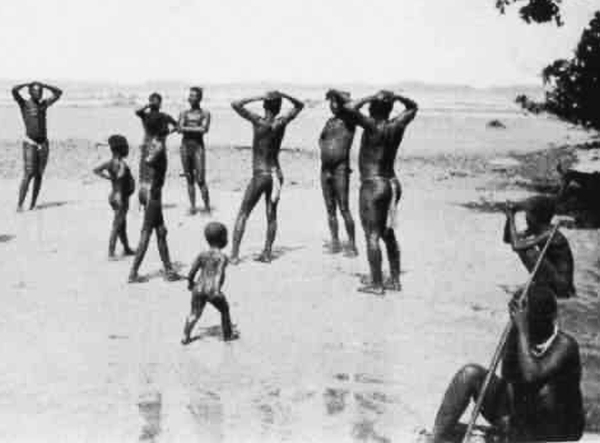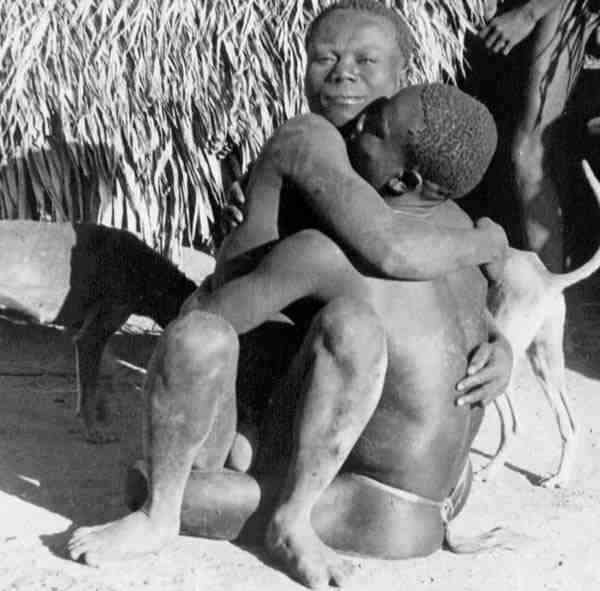3.1 The "Island of Cannibals"
The author of a book on the Andamans in the 1930s started his work with the exclamation "Andamans! - the very name sounds dreadful and calls forth an exclamation of wrath and disdain." This may be putting it a little strongly but the fact remains that from the dawn of recorded history the islands were feared for their alleged cannibalistic natives, their dangerous reefs, violent storms and fever-ridden swamps. The penal colony established after 1858 did nothing to improve the tarnished reputation. As if to cement their negative image, the islands have twice provided the stage to historical dramas. The first was when the vice-Roy of British India was murdered at Port Blair in 1872, the second during World War II when the Japanese army of occupation in the islands set up a short-lived puppet government of a pseudo-independent India in 1943.
The Alexandrian geographer Ptolemy living in the 2nd century BC seems to have had some knowledge of an in the general area of the Bay of Bengal. Whether this really did refer to the Andamans is an open question. There is no clear and specific reference to the islands until the 7th century AD when Arab and other sources mention cannibalism and very black men. Thereafter, mentions of the islands become more frequent and all mention cannibalism. The most famous early reporter was Marco Polo; he seems to have passed close to the islands in 1290 but never set foot on them. He wrote, from hearsay, that the inhabitants had heads, eyes and teeth like dogs and were no better than wild beasts, eating everybody that they would catch anyone who was not of their own race. There is nothing to be gained by listing the hostile notices surviving from this time onwards. They all say more or less the same and they all appear based on yarns picked up from travellers around the Bay of Bengal.
3.2 Contacts with slave raiding pirates
The early trepang (sea cucumber) and birds nest collectors were also pirates and slavers if opportunity presented itself. They used the many hidden Andamanese harbours while going about their business. It is highly likely that these entrepreneurs deliberately spread tall tales of horror about the islands - to keep competitors away. We have already mentioned the existence of isolated clumps of coconut palms in secluded anchorages as a clue to the existence of pirates' nests. Some must have found a modus vivendi for coexisting with the Andamanese, most likely based on the principle of keeping out of each others' way, perhaps occasionally expanding into silent trade. Silent trade is the exchange of trading goods without the necessity of the parties speaking or even meeting each other. The goods are left at an obvious spot where they are later picked up by the other party, who in turn leaves goods in payment at the same spot. The trading partners need never meet face to face.
How rare direct contact must have been was demonstrated, tragically, by the Andamanese susceptibility to disease introduced by outsiders after 1858. Moreover, no Arab, Malay, Indian or Burmese loan words predating 1858 have been identified in any of the Andamanese languages. The old Andamanese word for trepang (sea cucumber or bêche-de-mer) translates as "foreigners' slug".
Even without direct contact, a pirate could have been useful to the Andamanese around his hiding place. He could provide iron through silent trade and perhaps protect "his" natives from the predations of other pirates. The Andamanese themselves were profoundly ignorant of the outside world and barely aware of the existence of other Andamanese groups apart from their immediate neighbours. Their coexistence with a pirate in one area, therefore, would be no bar to the same pirate's slave-raiding in other parts of the islands. It must be said, however, that no hard evidence for these conjectures has so far been found.
To judge from the age of the coconut palms found on deserted anchorages, the last resident pirates abandoned the islands in the course of the 18th century, probably in response to the growing naval activity around the islands. The preference after the 18th century was for pirates, especially Malay and Burmese, to raid in the islands from bases from their home countries. A Chinese collector of edible bird's nests who was giving evidence in a case involving escaped Burmese convicts in 1862 knew the Burmese names for many geographical features in the Andamans. The names were widely known and obviously long-established. As late as 1884, the British authorities in the Andamans reported trouble with heavily-armed Malay vessels that were suspected of slaving activities. Their crews, when stopped and searched by British patrols, claimed to be collecting trepang (sea cucumber) and birds' nests.
That the locals suffered badly from slave raiding pirates over long periods there can be no doubt. There are too many references from early until quite recent times to "small black slaves" at Burmese, Indian, Malay, Indonesian and Thai courts. Not all need have been Andamanese Negritos or the victims of slave raiding but some undoubtedly were. Andamanese boats are known to have drifted out of sight of land by accident and such cases must have been fairly common from earliest times in view of the unpredictable seas and weather of the area. For one native adrift lucky enough to have been picked up by a passing civilized vessel, over the centuries thousands must have perished or fallen into the hands of slavers.
In 18th century Europe it was fashionable at courts and aristocratic houses to have "Negro" pages. Even Hollywood directors knew it and few are the period costume dramas without a decorative black page or two in the background. The historical pages seem to have stayed small and youthful for a very long time, so much so that the suspicion arises that they may not have been African blacks at all but, in fact, Negritos. The grandees who owned such living prestige objects did not care much about their origins. Africans and Negritos were not differentiated even in 19th century London as was made clear by the first Officer in Charge of the Andamanese, the Reverend Henry Corbyn, who mentioned in a letter of 1863 that an Andamanese man had for many years been carrying on trade as a tobacconist in London, passing for a "stunted African".
Until historically recent times, there was little to distinguish a pirate from a regular trading ship. Nor did all slavers in the Andamans come from nearby countries. In 1791, a French merchant navy captain is reported to have offered two Anda-manese captives for sale in Ceylon. Captains customarily took what they could, when they could. It should not be thought that special slaving trips like the well-organized, large-scale slave hunts that devastated so much of Africa took place in the Andamans. The ships that visited the islands were there primarily to collect trepang and birds' nests along with wood and fresh water or else to seek shelter from storms. However, visitors would not be above kidnapping a party of Andamanese if they happened to surprise one at sea or could cut one off on an open beach. In their familiar jungle habitat the extremely nimble Andamanese could escape and hide with ease from any raiding party foolish enough to crash through the underbrush in search of them. In the jungle, native marksmen could also pick off intruders at leisure and so persuade the surviving rest to beat a retreat to their ship. Only crews without local experience could think of slave-hunting in the jungle - they would be unlikely to repeat the mistake. On the other hand, out at sea in their sailless canoes, the Andamanese were defenceless against even the most primitive sailing ships.


